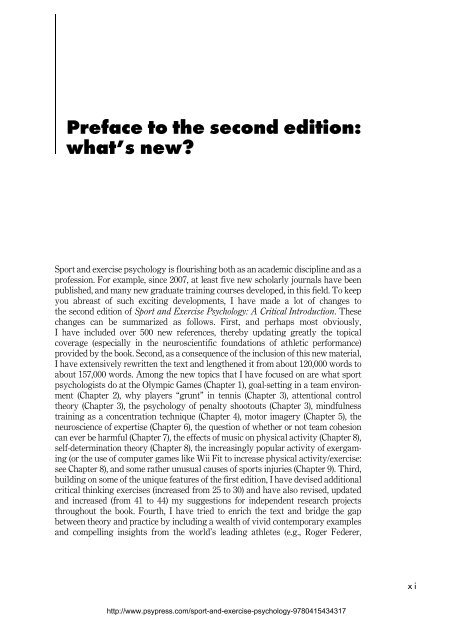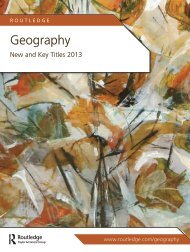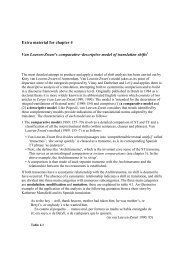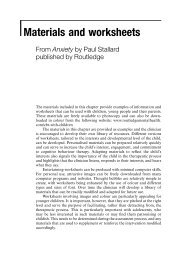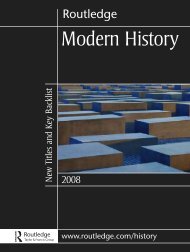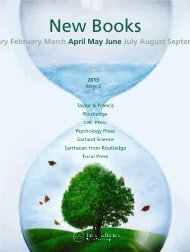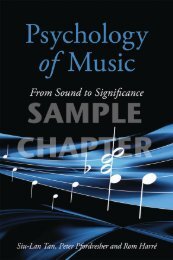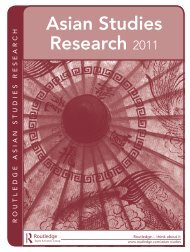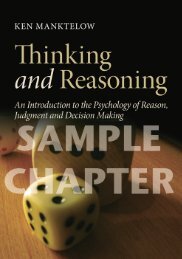Sport and Exercise Psychology: A Critical introduction ... - Routledge
Sport and Exercise Psychology: A Critical introduction ... - Routledge
Sport and Exercise Psychology: A Critical introduction ... - Routledge
You also want an ePaper? Increase the reach of your titles
YUMPU automatically turns print PDFs into web optimized ePapers that Google loves.
Preface to the second edition:<br />
what’s new?<br />
<strong>Sport</strong> <strong>and</strong> exercise psychology is flourishing both as an academic discipline <strong>and</strong> as a<br />
profession. For example, since 2007, at least five new scholarly journals have been<br />
published, <strong>and</strong> many new graduate training courses developed, in this field. To keep<br />
you abreast of such exciting developments, I have made a lot of changes to<br />
the second edition of <strong>Sport</strong> <strong>and</strong> <strong>Exercise</strong> <strong>Psychology</strong>: A <strong>Critical</strong> Introduction. These<br />
changes can be summarized as follows. First, <strong>and</strong> perhaps most obviously,<br />
I have included over 500 new references, thereby updating greatly the topical<br />
coverage (especially in the neuroscientific foundations of athletic performance)<br />
provided by the book. Second, as a consequence of the inclusion of this new material,<br />
I have extensively rewritten the text <strong>and</strong> lengthened it from about 120,000 words to<br />
about 157,000 words. Among the new topics that I have focused on are what sport<br />
psychologists do at the Olympic Games (Chapter 1), goal-setting in a team environment<br />
(Chapter 2), why players “grunt” in tennis (Chapter 3), attentional control<br />
theory (Chapter 3), the psychology of penalty shootouts (Chapter 3), mindfulness<br />
training as a concentration technique (Chapter 4), motor imagery (Chapter 5), the<br />
neuroscience of expertise (Chapter 6), the question of whether or not team cohesion<br />
can ever be harmful (Chapter 7), the effects of music on physical activity (Chapter 8),<br />
self-determination theory (Chapter 8), the increasingly popular activity of exergaming<br />
(or the use of computer games like Wii Fit to increase physical activity/exercise:<br />
see Chapter 8), <strong>and</strong> some rather unusual causes of sports injuries (Chapter 9). Third,<br />
building on some of the unique features of the first edition, I have devised additional<br />
critical thinking exercises (increased from 25 to 30) <strong>and</strong> have also revised, updated<br />
<strong>and</strong> increased (from 41 to 44) my suggestions for independent research projects<br />
throughout the book. Fourth, I have tried to enrich the text <strong>and</strong> bridge the gap<br />
between theory <strong>and</strong> practice by including a wealth of vivid contemporary examples<br />
<strong>and</strong> compelling insights from the world’s leading athletes (e.g., Roger Federer,<br />
http://www.psypress.com/sport-<strong>and</strong>-exercise-psychology-9780415434317<br />
xi


